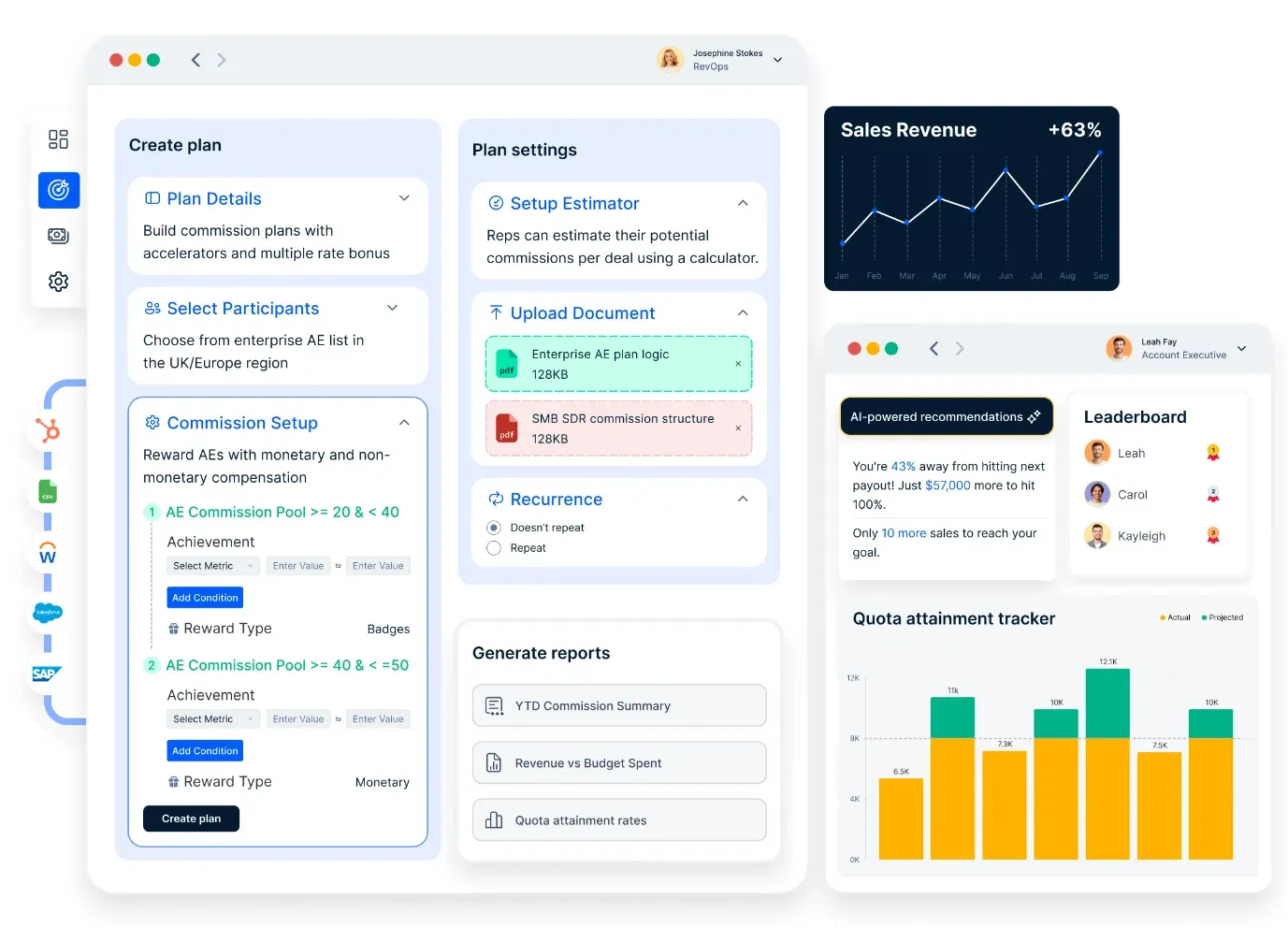A Complete Guide to Manufacturer Sales Rep Commission Rate
اكتشف أحدث معدلات عمولات مندوبي المبيعات في الولايات المتحدة الأمريكية. تعرف على كيفية عمل العمولات، ومعايير الصناعة، والعوامل المؤثرة على المعدلات.
في هذه الصفحة
تُعد معدلات عمولة مندوبي المبيعات لدى المُصنِّعين محورية في إبرام صفقة فعالة بين المُصنِّعين ومندوبي المبيعات.
يمكن أن تؤدي معدلات العمولة المتدنية إلى تثبيط الحافز وعدم الرضا، بل وحتى الاستنزاف بين مندوبي المبيعات، مما قد يؤثر على صافي أرباح الشركة المصنعة.
As per Forbes, a mere 5 percent increase in the average sales rep attrition rate can escalate selling costs by 4 to 6 percent while reducing total revenue by 2 to 3 percent.
In the manufacturing industry the sales rep commission rate is between 7 to 15 percent.
The average yearly income of sales reps is around $62,720, and the average hourly wage is $30.16.
These numbers highlight the significance of retaining sales reps.
Commission dynamics in the sales ecosystem is a major factor in retaining sales representatives, which calls for an in-depth study and evaluation of the manufacturer's sales rep commission rates.
ونحن هنا لتزويدك بكل المعلومات اللازمة.
في هذه المقالة، نلقي نظرة على تفاصيل عمولة مندوبي الشركات المصنّعة، ونكشف عن العوامل التي تؤثر عليها، وأنواعها، وإجراءات التدرج في العمولة، والمعدلات القياسية وبعض دراسات الحالة للرجوع إليها.
What is a manufacturing sales commission plan?
A manufacturing sales commission plan is a structured compensation model that determines how much a sales representative earns based on their performance. This commission structure typically includes a percentage-based payout influenced by factors such as deal type, value, and size. Additionally, it considers the rep’s experience and seniority within the organization.
A well-designed manufacturing sales commission plan not only incentivizes sales teams but also aligns their efforts with the company’s revenue goals. When implemented effectively, it offers several benefits, including:
Higher sales rep retention
A competitive commission plan encourages sales representatives to stay with the company. When reps feel adequately rewarded for their efforts, turnover rates decrease, and retention improves.
Increased sales productivity
A well-structured commission plan motivates sales reps to improve their performance, meet targets, and drive higher revenue. Clear incentives push them to close more deals efficiently.
تعزيز أداء المبيعات المحسّن
When a commission structure aligns with business goals and offers lucrative incentives, sales teams are more likely to exceed targets and bring in consistent revenue.
Beyond these core benefits, a well-planned sales commission structure fosters a healthy competitive environment, boosts overall revenue, and keeps sales teams continuously motivated to perform better.
والآن، السؤال الذي يطرح نفسه، هل عمولات المبيعات هي التكلفة العامة للتصنيع؟
نعم، تندرج تحت التكاليف العامة المتغيرة للتصنيع حيث يتغير المبلغ في كل مرة ويعتمد على عدد الوحدات المباعة.
ومع ذلك، هناك العديد من الهياكل والعوامل المختلفة التي تؤثر على قرار تحديد معدلات العمولة، دعنا ننتقل إليها.
العوامل المؤثرة على معدلات عمولة مندوب مبيعات التصنيع
يمكن أن تختلف معدلات عمولة مندوبي المبيعات لدى المصنعين اختلافاً كبيراً لأنها تتأثر بعوامل مختلفة في الولايات المتحدة الأمريكية. حيث يجب أن يكون هيكل العمولة بحيث يدعم أهداف الشركة المصنعة وديناميكيات السوق واستراتيجية المبيعات.
العاملان الرئيسيان اللذان يؤثران على معدلات العمولة هما:
1. الاعتبارات الخاصة بالصناعة
- Product type - The type of product and its complexity in being sold affects the commission rates. For example, High-tech or highly specialized products can entitle higher commissions due to the skill and effort required to market them.
- Sales cycle length - From lead generation to contract completion, the length of the sales cycle is a crucial aspect in deciding the rates. Higher commission rates might be necessary for longer sales cycles to maintain sales reps' motivation.
- Profit margins - Profit margins associated with the product can impact commission rates. Products with higher profit margins can have greater commissions than others.
- Competitors commission - Manufacturers are always at risk of losing their best sales reps. The best way to avoid this is to know what commission rates competitors offer to their reps. This will help to set commission rates accordingly.
2. العوامل الخاصة بالشركة
- Sales strategy - Commission rates depend on the manufacturer's sales strategy, whether it's market penetration, customer retention, or new product launches. Aligning commission structures with sales objectives will make sure your sales reps are motivated.
- Budget - The financial objectives of the manufacturer directly influence commission rates. Companies set commission rates based on their revenue goals, budgetary constraints, and overall financial strategy.
- Historical performance and data analysis - To assess what commission rates have been successful in achieving desired goals, manufacturers usually analyze historical data, sales metrics and decide the rates.
Which is an ideal manufacturing sales commission plan to adopt?
Here are four ideal manufacturing sales commission plans that align with revenue goals:
1. الراتب الأساسي بالإضافة إلى العمولة
This structure includes a base salary plus a performance-based commission. The base salary ensures financial stability, while commissions motivate reps to improve performance. It helps balance fixed and variable costs, ensuring sustainable business operations.
هذا الهيكل مثالي لـ
- الشركات التي تتطلع إلى تحقيق التوازن بين عمولات المبيعات الثابتة والمتغيرة في عمولات التصنيع الثابتة والمتغيرة.
- الشركات التي يمكن أن يختلف فيها حجم المبيعات على مدار العام.
- الشركات التي ترغب في تشجيع جهود المبيعات الاستباقية.
When to use: Ideal for small and mid-sized manufacturing businesses looking to attract and retain top sales talent by offering both financial stability and performance-based incentives.
2. خطة عمولة مباشرة
This structure compensates sales reps solely based on commissions, eliminating base salary costs. It motivates reps to close more deals while allowing management to control variable expenses. However, unpredictable income may lead to high turnover if commissions are not competitive.
هذا الهيكل مثالي لـ
- الشركات أو الشركات الناشئة التي قد لا يكون لديها وسائل ثابتة لزيادة رأس المال تدفع لمندوبي مبيعاتها.
- الشركات ذات دورات المبيعات القصيرة أو تلك التي يمكن لمندوبي المبيعات فيها كسب عمولة كبيرة على عملية بيع واحدة فقط.
When to use: Best suited for businesses with aggressive sales targets or those operating with limited capital, such as startups.
3. Gross margin commission structure
This model rewards sales reps based on gross margin rather than total sales, encouraging them to focus on selling high-margin products.
هذا الهيكل مثالي لـ
- الشركات الكبيرة بالفعل ولديها فرق مبيعات راسخة.
- الشركات التي ترغب في تحسين حماس مندوبي المبيعات لديها وزيادة المبيعات، حيث قد يكون المندوبون أكثر تحفيزًا للتفوق في الأداء من أجل التقدم إلى المستوى التالي.
Gross Margin x Commission Percentage = Total Commission
When to use: Ideal for manufacturing companies looking to maintain profitability while ensuring that sales reps focus on high-margin products.
4. Territory volume commission
This structure distributes commission revenue among all sales reps operating in a specific region, fostering teamwork and collaboration. However, it may create conflicts if multiple reps are assigned the same territory.
When to use: Best for manufacturers expanding into new markets or operating at national and international levels.
5. Tiered Commission
في نموذج العمولة المتدرج، ترتفع العمولة إذا حقق مندوب المبيعات هدفاً محدداً، مثل بيع عدد محدد مسبقاً من السلع أو تحقيق هدف معين من الإيرادات. ولتشجيع مندوبي المبيعات على تحقيق الهدف التالي، تقرر العديد من الشركات إنشاء مستويات متعددة لعمولة المبيعات.
لا يحصل مندوبو المبيعات على مبلغ مقطوع بعد الوصول إلى الهدف المحدد. فهم يحصلون بشكل عام على نسبة مئوية معينة على جميع المبيعات حتى يصلوا إلى المستوى التالي. تكون النسبة المئوية لزيادة العمولة حسب كل مستوى. يمكن فهم ذلك بشكل أفضل من خلال المثال أدناه.
هذا الهيكل مثالي لـ
- الشركات الكبيرة بالفعل ولديها فرق مبيعات راسخة.
- الشركات التي ترغب في تحسين حماس مندوبي المبيعات لديها وزيادة المبيعات، حيث قد يكون المندوبون أكثر تحفيزًا للتفوق في الأداء من أجل التقدم إلى المستوى التالي.
دراسة حالة
- تتبع شركة المشروبات العملاقة كوكاكولا Coca-Cola هيكل عمولة متدرج.
- فهم يدفعون لوكلاء مبيعاتهم عمولة أعلى إذا أتموا المزيد من الصفقات وتجاوزوا الحصص والمستويات المحددة لهم.
- Reportedly, on an average they pay sales reps a base salary of $48,000 with a $10,000 bonus annually.
4. التعادل مقابل عمولة
يحصل مندوب المبيعات على عمولته مقدمًا من خلال خطة سحب قابلة للاسترداد مقابل العمولة. تظهر عادةً كدفعة مقطوعة ثابتة في بداية دورة الدفع أو دورة المبيعات.
يتم خصم هذا المبلغ المقطوع أو السحب من إجمالي العمولات المكتسبة للمندوب في نهاية دورة المبيعات تلك. في نموذج العمولة غير القابلة للاسترداد، إذا كانت عمولة مندوب المبيعات أقل من المبلغ المقطوع، فلا يمكن استرداد عمولة السحب.
هذا الهيكل مثالي لـ
- الشركات الجديدة في مجال المبيعات، يعمل هذا الترتيب بشكل جيد. فالضغط المتزايد يضمن وصول مندوب المبيعات إلى مبلغ السحب.
- الشركات ذات دورات المبيعات غير المتوقعة والمنتجات غير الموسمية.
If the earned commission is less than the draw, the salesperson owes the difference.
Non-recoverable draw (Guaranteed minimum pay)
Final Pay = Max 0 (Draw Amount, Earned Commission)
The salesperson keeps the draw even if the commission earned is lower.
How to set up fair commission rates?
من الضروري أن تكون معدلات عمولة مندوبي المبيعات لدى الشركة المصنعة عادلة بما فيه الكفاية وتنافسية وجذابة لمندوبي المبيعات، من أجل تحقيق أهداف المبيعات والمساهمة في نمو الأعمال.
فيما يلي بعض الاعتبارات لإعداد معدلات عمولة عادلة:
1. أبحاث السوق والمقارنة المرجعية
- للبدء، قم بإجراء بحث متعمق في السوق للتعرف على معايير الصناعة ومعدلات العمولة الجارية للمنتجات المماثلة.
- ستمنحك المقارنة المعيارية مع المنافسين معلومات مفيدة حول ما يعتبره السوق عادلاً.
2. إنشاء هيكل عمولة مخصص
- صمم هيكل عمولة يتماشى مع أهداف مؤسستك ونوع المنتج وديناميكيات السوق في مؤسستك.
- يجب أن تؤخذ في الاعتبار عمولات المبيعات ونفقات التصنيع العامة وهوامش الربح وأهداف المبيعات وتعقيدات السلع أو الخدمات.
- تأكد من أن الهيكل مجدٍ للشركة مع تحفيز مندوبي المبيعات في الوقت نفسه.
3. البدء في تقديم عمولة لمندوب المبيعات
- By establishing all of the terms and conditions in a written agreement or contract, implement the commission structure.
- تأكّد من أن مندوبي المبيعات على دراية بكيفية تحديد العمولات ودفعها وأي متطلبات يجب عليهم الوفاء بها من أجل الحصول على العمولات.
4. دمج حلقات التغذية الراجعة
- يجب إنشاء قنوات اتصال مباشرة مع فريق المبيعات، كما يجب جمع الملاحظات حول نظام العمولة.
- تواصل مع مندوبي المبيعات بشكل منتظم للاستماع إلى أفكارهم وتجاربهم فيما يتعلق بعدالة معدلات العمولة. على سبيل المثال، إجراء استبيان أو ترتيب مناقشات جماعية.
- استخدم هذه المدخلات لتعديل هيكل العمولة وتحسينه إذا لزم الأمر للحفاظ على عدالته وتحفيزه.
How to calculate manufacturing sales commission in 5 simple steps?
Determining a fair commission rate is crucial for manufacturers to motivate their sales teams and drive revenue. Here are five simple steps to help you calculate manufacturing sales commission accurately:
Step 1: Decide on your ideal commission structure
Start by selecting the right commission structure for your sales team. Consider different commission models—such as fixed, tiered, or profit-based—along with their benefits and drawbacks. Define the commission percentage, influencing factors like deal size and type, and any additional incentives like quotas and bonuses. A well-planned structure ensures fair compensation and boosts sales performance.
Step 2: Gather sales data for a defined period
Accurate sales data is essential for fair commission payouts. Collect and organize sales data for a specific period—monthly, quarterly, or annually. Use Compass to gain deeper insights into sales performance.
Keep in mind that commission payouts may vary based on company policies. Some companies delay commissions until they receive full payment from customers, which can result in a delay of several weeks. While this policy may seem unfair to sales reps, it helps businesses manage cash flow, especially when dealing with high-value transactions.
Step 3: Calculate gross sales
Once the sales data is collected, calculate the total gross sales for the given period. Categorize sales by product or service type, and factor in any adjustments, such as returns or refunds, to ensure accuracy. Understanding these figures helps in determining the correct commission payout.
Step 4: Determine the base commission rate while considering additional factors
Multiply the total sales figure by the designated commission rate to determine the base commission. If using a tiered commission structure, adjust payouts based on performance thresholds. Consider factors like quota-based incentives, performance bonuses, and deductions (such as chargebacks) to ensure a fair and balanced commission plan.
Step 5: Calculate the final commission payout
In the final step, sum up all adjustments, bonuses, and deductions to determine the exact commission payout. Ensure transparency by clearly communicating the commission breakdown with sales reps and addressing any concerns they may have.
Why use Compass for manufacturing sales commission management?

إذا كنت مُصنّعاً يتطلع إلى:
- تبسيط إدارة العمولة,
- توفير الوقت والموارد
- أثناء تحفيز فريق المبيعات الخاص بك,
Then Compass is the right partner. It can enable:
- Automated commission tracking & payouts – No manual calculations or spreadsheets.
- Real-time integration with CRMs and ERPs – Seamlessly pulls sales data from existing tools.
- Customizable commission structures – Supports fixed, tiered, quota-based, and profit-sharing models.
- Transparent earnings dashboard – Reps can track their commissions in real time.
- Error-free calculations – Eliminates disputes and ensures timely, fair payouts.
Consider Compass. Book a demo today! To know how Compass, a sales commission automation platform, can revolutionize your sales commission process.
استنتاج
Commission dynamics are pivotal in optimizing the manufacturer sales rep relationship and driving sales performance. The above guide will help you set up an appropriate manufacturer's sales rep commission rates and succeed. In this blog, we learned:
- A well-defined manufacturing sales commission plan improves sales performance and retention.
- Gathering and organizing sales data is crucial for fair commission calculations.
- Using Compass automates sales commission tracking, reducing errors and disputes.
- Considering quotas, bonuses, and chargebacks ensures a balanced compensation system.
- Clearly communicating commission structures and automating payouts boosts sales rep motivation and trust.
الأسئلة الشائعة
What is the commission for manufacturing sales?
Manufacturing sales commissions typically range from 2% to 10%, depending on factors like industry, product complexity, and sales volume.
How much commission does a car salesman make on a $50,000 car?
Car sales commissions vary but generally range from 2% to 5%. On a $50,000 car, this would be $1,000 to $2,500, though some dealerships offer flat fees or bonuses instead.
How does a manufacturing company classify sales commissions?
Sales commissions in manufacturing are classified as a selling expense under operating expenses, since they are directly related to revenue generation rather than production.
Is sales commission a manufacturing overhead cost?
No, sales commission is not a manufacturing overhead cost. It is a selling expense, as it is not directly tied to production but rather to selling efforts.
How would a 5% sales commission paid to sales personnel be classified in a manufacturing company?
A 5% sales commission would be classified as a selling expense under the company's income statement, impacting the operating expenses rather than the cost of goods manufactured.













